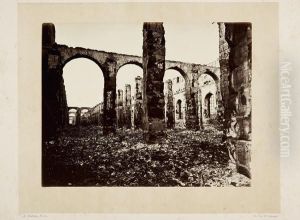Alphonse J. Liebert Paintings
Alphonse J. Liebert was a French-born photographer who made significant contributions to the field of photography in the 19th century. Born in 1827, Liebert's journey into photography began after he moved to the United States, where he eventually became recognized for his skill and innovative approaches to photographic processes and compositions. His work spanned various subjects, including portraits, landscapes, and architectural photography, capturing the essence and beauty of his era with remarkable precision and artistic sensitivity.
Liebert's photographic career is noted for its diversity and the quality of his images, which were characterized by their clarity, depth, and attention to detail. He was adept at using the photographic technologies available at the time, such as the daguerreotype, ambrotype, and tintype processes, which were the leading methods for creating images. Throughout his career, Liebert experimented with these techniques, improving and adapting them to suit his artistic vision, which helped to advance the field of photography.
In addition to his technical skills, Liebert had a keen eye for composition and lighting, which allowed him to create striking and emotive images. His portraits, in particular, are noted for their ability to capture the personality and essence of the subject, a testament to his skill as both a photographer and an observer of human nature. Liebert's landscape and architectural photographs also stand out for their meticulous framing and the way they convey the grandeur and beauty of their subjects.
Despite his contributions and the quality of his work, Alphonse J. Liebert remains a relatively obscure figure in the history of photography. His death in 1913 marked the end of a career that had spanned several decades, during which he had witnessed and contributed to the evolution of photography from its infancy to a fully-fledged form of artistic and documentary expression. Today, Liebert's photographs are valuable not only for their artistic merit but also as historical documents that offer insight into the world of the 19th century.
